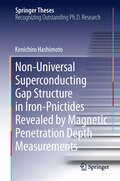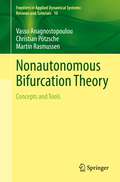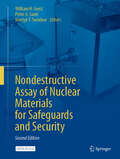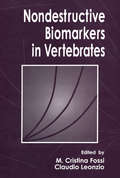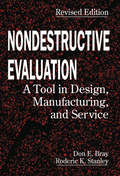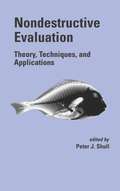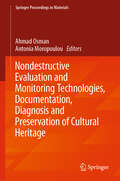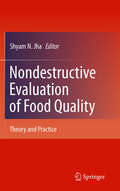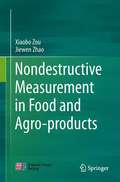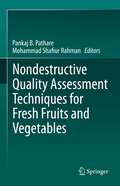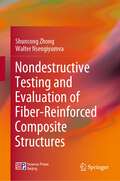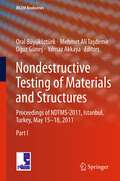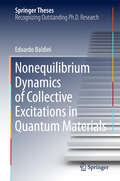- Table View
- List View
Non-traditional Micromachining Processes
by Golam Kibria B. Bhattacharyya J. Paulo DavimThis book presents a complete coverage of micromachining processes from their basic material removal phenomena to past and recent research carried by a number of researchers worldwide. Chapters on effective utilization of material resources, improved efficiency, reliability, durability, and cost effectiveness of the products are presented. This book provides the reader with new and recent developments in the field of micromachining and microfabrication of engineering materials.
Non-Universal Superconducting Gap Structure in Iron-Pnictides Revealed by Magnetic Penetration Depth Measurements
by Kenichiro HashimotoIn this book the author presents two important findings revealed by high-precision magnetic penetration depth measurements in iron-based superconductors which exhibit high-transition temperature superconductivity up to 55 K: one is the fact that the superconducting gap structure in iron-based superconductors depends on a detailed electronic structure of individual materials, and the other is the first strong evidence for the presence of a quantum critical point (QCP) beneath the superconducting dome of iron-based superconductors. The magnetic penetration depth is a powerful probe to elucidate the superconducting gap structure which is intimately related to the pairing mechanism of superconductivity. The author discusses the possible gap structure of individual iron-based superconductors by comparing the gap structure obtained from the penetration depth measurements with theoretical predictions, indicating that the non-universal superconducting gap structure in iron-pnictides can be interpreted in the framework of A1g symmetry. This result imposes a strong constraint on the pairing mechanism of iron-based superconductors. The author also shows clear evidence for the quantum criticality inside the superconducting dome from the absolute zero-temperature penetration depth measurements as a function of chemical composition. A sharp peak of the penetration depth at a certain composition demonstrates pronounced quantum fluctuations associated with the QCP, which separates two distinct superconducting phases. This gives the first convincing signature of a second-order quantum phase transition deep inside the superconducting dome, which may address a key question on the general phase diagram of unconventional superconductivity in the vicinity of a QCP.
Non-Volatile CBRAM/MIM Switching Technology for Electronically Reconfigurable Passive Microwave Devices: Theory and Methods for Application in Rewritable Chipless RFID
by Jayakrishnan M. Purushothama Etienne Perret Arnaud VenaThis book presents the applications of non-volatile CBRAM/MIM switching technology for electronically reconfigurable passive RF and microwave devices, together with theory and methods for application in rewritable chipless RFID tags. Conductive Bridging Random Access Memory (CBRAM) is a renowned and commercially used non-volatile memory concept. Having evolved over the past few decades, it is currently identified as an efficient non-volatile RF switching technology.This book presents recent research on this topic, focusing on the development of a new generation of low-cost non-volatile RF switches and their applications, demonstrating both high performance and flexibility of implementation. It includes the experimental realization of various prototypes of RF and microwave devices utilizing this technology, along with relevant analysis of mathematical and electrical models, and detailed discussions of future aspects. All devices presented are compatible with mass industrial production at an economically efficient budget through optimized fabrication steps, without the requirement of sophisticated “clean room” processes among them.
Non-volatile Memories
by Pierre-Camille Lacaze Jean-Claude LacroixWritten for scientists, researchers, and engineers, Non-volatile Memories describes the recent research and implementations in relation to the design of a new generation of non-volatile electronic memories. The objective is to replace existing memories (DRAM, SRAM, EEPROM, Flash, etc.) with a universal memory model likely to reach better performances than the current types of memory: extremely high commutation speeds, high implantation densities and retention time of information of about ten years.
Non-Wood Forest Products of Asia: Knowledge, Conservation and Livelihood (World Forests #25)
by A. Z. M. Manzoor Rashid Niaz Ahmed Khan Mahmood HossainThis book highlights the importance of non-wood forest products (NWFPs) and their crucial role in sustaining the livelihood of rural and indigenous communities in Asia. The authors depict how the preservation of forests and the associated major non-wood resources may provide an important avenue to reduce poverty. The local practices and knowledge on harvesting NWFPs are often rooted in tradition, and vary from one region to the other. This made it difficult to develop and establish research focus on a greater scale in the past. Readers of this volume will gain an often-missed, broader perspective from these new studies. The authors put a special emphasis on the nexus between conservation and livelihood from an Asian point of view. This addresses a knowledge gap in the current literature and offers important clues on conducting similar research around the world. The volume provides a useful reference guide for the relevant researchers, practitioners and policy makers.
Nonacademic Writing: Social Theory and Technology
by Ann Hill DuinIn this volume, methodological, cultural, technological, and political boundaries felt by writers are analyzed, translated, and challenged in a way that will appeal to researchers, theorists, graduate students, instructors, and managerial audiences. Instead of extracting rules from previous research, the contributors, working from multidisciplinary perspectives, describe and analyze the social and technological contexts surrounding nonacademic writing. Their essays present a formative rather than summative outlook toward future research on nonacademic writing. Collectively, these chapters articulate a unique perspective toward nonacademic writing that considers: * The centrality of emerging communications technologies in nonacademic writing research and the need for a socio-technological perspective. New technologies reshape the concept of text and significantly impact the writing process and written products in nonacademic settings. * The relationship between the academy and the workplace. A number of chapters challenge us -- sometimes from opposing perspectives -- to scrutinize our role as writing educators in preparing students for the workplace. Should we support the interests of corporate employers, or should we resist those interests? Should we enculturate students in workplace writing practices by placing them in these environments, or should we examine the tacit knowledge gained by workplace professionals and deliver this via classroom instruction? * New theory, new research agendas. Contributors from diverse fields offer new theoretical lenses or use established lenses in innovative ways, expanding the agenda for nonacademic writing research. This volume represents the vision the social landscape demands for research and pedagogy in nonacademic writing.
Nonautonomous Bifurcation Theory: Concepts and Tools (Frontiers in Applied Dynamical Systems: Reviews and Tutorials)
by Vasso Anagnostopoulou Christian Pötzsche Martin RasmussenBifurcation theory is a major topic in dynamical systems theory with profound applications. However, in contrast to autonomous dynamical systems, it is not clear what a bifurcation of a nonautonomous dynamical system actually is, and so far, various different approaches to describe qualitative changes have been suggested in the literature. The aim of this book is to provide a concise survey of the area and equip the reader with suitable tools to tackle nonautonomous problems. A review, discussion and comparison of several concepts of bifurcation is provided, and these are formulated in a unified notation and illustrated by means of comprehensible examples. Additionally, certain relevant tools needed in a corresponding analysis are presented.
Nonconventional Concrete Technologies: Renewal of the Highway Infrastructure
by Committee on Nonconventional Concrete Technologies for Renewal of the Highway InfrastructureA report on Nonconventional Concrete Technologies:
Noncovalent Functionalization of Carbon Nanotubes
by Claudia BackesIn this thesis, Claudia Backes guides the reader through her multidisciplinary research into the non-covalent functionalization of carbon nanotubes in water. Although one of the most remarkable materials of the 21st century, carbon nanotubes often have limited application because of their intrinsically low solubility and polydispersity. The author shows that rational surfactant design is a powerful tool for chemists because it can unmask the key to solubilization and allow us to tailor nanotube surface and optical properties in a fully reversible fashion. Aspects of organic, physical and analytical chemistry, as well as colloidal sciences are covered in this outstanding work which brings us one step closer to exploiting this super-material to its full potential.
Nondestructive Assay of Nuclear Materials for Safeguards and Security
by William H. Geist Peter A. Santi Martyn T. SwinhoeThis open access book describes the nondestructive assay techniques that are used for the measurement of nuclear material (primarily uranium and plutonium) for nuclear material accountancy purposes. It is a substantial revision to the so-called PANDA manual that has been a standard reference since its publication in 1991. The book covers the origin and interactions of gamma rays and neutrons as they affect nuclear measurements and also describes the theory and practice of calorimetry. The book gives a description of many instruments based on these techniques that are applied in the field. Although the basic physics has not changed since PANDA was first published, the last thirty years have seen many advances in analysis methods, instrumentation, and applications. The basic descriptions of the origin and interactions of radiation have been updated and include newer references. There have been extensive revisions of the description of gamma detection methods, attenuation correction procedures, and analysis methods, including for the measurement of uranium enrichment and the determination of plutonium isotopic composition. Extensive revisions and additions have also been made to the description of neutron detectors and to the explanation of neutron coincidence techniques. The chapter on neutron multiplicity techniques is a new addition to this edition. The applications of gamma and neutron techniques have been completely overhauled to remove obsolete systems and to include many current applications. The values of, and references to, nuclear data have been updated. This updated edition is an essential reference for academic researchers and practitioners in the field. This is an open access book.
Nondestructive Biomarkers in Vertebrates
by Cristina Fossi Claudio LeonzioNondestructive Biomarkers in Vertebrates presents an innovative approach for hazard assessment in vertebrates based on nondestructive rather than destructive methods. The book reviews the state of the art and defines the development and validation procedure of this new strategy. Biological materials, such as blood samples, epithelial tissue, eggs, feathers, and feces that can be obtained without stress or damage to the animal are suggested. Certain traditional studies (blood esterases, blood chemistry, mixed function oxidases, porphyrins, DNA damage, and cytological changes) can be performed on these specimens, along with new tests requiring only very small samples. This approach is developed to benefit protected, threatened species whose existence cannot be further jeopardized by the use of destructive methods. This volume will be particularly useful to ecotoxicologists, wildlife protection personnel, environmental consultants, and conservationist organizations.
Nondestructive Characterization of Composite Media
by RobertA. KlineA guide to NDE of composite materials by acoustic wave propagation, including advanced ultrasound methods, for detailed identification and measurement of defects, and characterization of microstructure and properties. ""The major objective is to present the basic concepts of wave propagation in anisotropic media, and to show how these concepts can be applied to the quantitative, nondestructive evaluation of composite media.
Nondestructive Evaluation: A Tool in Design, Manufacturing and Service
by Don E. Bray Roderick K. StanleyNondestructive evaluation (NDE) inspection schemes are important in design, manufacturing, and maintenance. By correctly applying techniques of NDE, we can reduce machine and system failures and increase reliability of operating systems over an extended lifetime. Nondestructive Evaluation: A Tool in Design, Manufacturing, and Service introduces and discusses primary techniques used in the field, including ultrasonics, acoustic emission, magnetics, radiography, penetrants, and eddy currents. Examples of each of these techniques are included, demonstrating typical applications.
Nondestructive Evaluation: Theory, Techniques, and Applications (Mechanical Engineering)
by Peter J. ShullDescribing NDE issues associated with real-world applications, this comprehensive book details conventional and forthcoming NDE technologies. It instructs on current practices, common techniques and equipment applications, and the potentials and limitations of current NDE methods. Each chapter details a different method, providing an overview, an e
Nondestructive Evaluation and Monitoring Technologies, Documentation, Diagnosis and Preservation of Cultural Heritage (Springer Proceedings in Materials)
by Ahmad Osman Antonia MoropoulouThis book highlights the benefits of Non-Destructive Testing (NDT) methods and their applications on several cultural heritage sites including the Holy Selphuchre Monitoring System in Jerusalem. This book demonstrates Nondestructive sensing technologies and inspection modules as main tools for documentation, diagnosis, characterization, preservation planning, monitoring and quality of restoration, assessment and evaluation of material and preservation work.
Nondestructive Evaluation of Food Quality
by Shyam N. JhaNumerous works on non-destructive testing of food quality have been reported in the literature. Techniques such as Near InfraRed (NIR) spectroscopy, color and visual spectroscopy, electronic nose and tongue, computer vision (image analysis), ultrasound, x-ray, CT and magnetic resonance imaging are some of the most applied for that purpose and are described in this book. Aspects such as theory/basics of the techniques, practical applications (sampling, experimentation, data analysis) for evaluation of quality attributes of food and some recent works reported in literature are presented and discussed. This book is particularly interesting for new researchers in food quality and serves as an updated state-of-the-art report for those already familiar with the field.
Nondestructive Food Evaluation: Techniques to Analyze Properties and Quality (ISSN)
by Sundaram GunasekaranThis volume illustrates significant changes in optical, magnetic, ultrasonic, mechanical and biological nondestructive evaluation techniques for online automatic control of food quality evaluation, including X-ray tomography. It presents advances in computer vision, X-ray imaging, ultrasonics, biosensors, and data analysis.
Nondestructive Measurement in Food and Agro-products
by Xiaobo Zou Jiewen ZhaoThis book is composed of 8 chapters, each focusing on a major non-destructive technique, including optical, acoustic and biological methods. The content of each chapter is based on the author's studies and current research developments. The book is aimed at graduate students, senior undergraduate students, and researchers in academia and industry. It will be particularly interesting for researchers in the fields of food, agricultural engineering, biotechnology and applied mathematics. It will also serve as a useful reference source for people working in the design and manufacture of non-destructive devices for food and agricultural products.
Nondestructive Quality Assessment Techniques for Fresh Fruits and Vegetables
by Pankaj B. Pathare Mohammad Shafiur RahmanThis book describes the various techniques for nondestructive quality assessment of fruits and vegetables. It covers the methods, measurements, operation principles, procedures, data analysis, and applications for implementing these techniques.The book presents the details of nondestructive approaches focusing on the present-day trends and existing future opportunities in the fresh food supply chain. First, it overviews different nondestructive techniques in food quality detection. Then it presents nondestructive methods: monochrome computer vision, imaging techniques, biospeckle laser technique, Fourier Transform Infrared (FTIR) Spectroscopy, hyperspectral imaging, Raman spectroscopy, near infrared (NIR) spectroscopy, X-ray computed tomography, ultrasound, acoustic emission, chemometrics, electronic nose and tongue. Selected applications of each method are also introduced. As a result, readers gain a better understanding of how to use nondestructive methods and technologies to detect the quality of fresh fruits and vegetables.With a wide range of interesting topics, the book will benefit readers including postharvest & food scientists/technologists, industry personnel and researchers involved in fresh produce quality detection. The book can also serve as a readily accessible reference material for postgraduate students.
Nondestructive Techniques for the Assessment and Preservation of Historic Structures
by Luisa Maria Gonçalves Hugo Rodrigues Florindo GasparNew technologies play an increasingly important role in the analysis, monitoring, restoration, and preservation of historic structures. These technological systems continue to get more advanced and complex, for example: 3D digital construction and documentation programming, 3D imaging data (including laser scanning and photogrammetry), multispectral and thermographic imaging, geophysical data, etc. This book will present the latest nondestructive technologies used in the characterization, preservation, and structural health monitoring of historic buildings. It will include numerous case studies, as well as theoretical explanations about each of the methods and technologies used in each.
Nondestructive Testing and Evaluation of Fiber-Reinforced Composite Structures
by Shuncong Zhong Walter NsengiyumvaThis book presents a detailed description of the most common nondestructive testing(NDT) techniques used for the testing and evaluation fiber-reinforced composite structures, during manufacturing and/or in service stages. In order to facilitate the understanding and the utility of the different NDT techniques presented, the book first provides some information regarding the defects and material degradation mechanisms observed in fiber-reinforced composite structures as well as their general description and most probable causes. It is written based on the extensive scientific research and engineering backgrounds of the authors in the NDT and structural health monitoring (SHM) of structural systems from various areas including electrical, mechanical, materials, civil and biomedical engineering. Pursuing a rigorous approach, the book establishes a fundamental framework for the NDT of fiber-reinforced composite structures, while emphasizing on the importance of technique’s spatial resolution, integrated systems analysis and the significance of the influence stemming from the applicability of the NDT and the physical parameters of the test structures in the selection and utilization of adequate NDT techniques.The book is intended for students who are interested in the NDT of fiber-reinforced composite structures, researchers investigating the applicability of different NDT techniques to the inspections of structural systems, and NDT researchers and engineers working on the optimization of NDT systems for specific applications involving the use of fiber-reinforced composite structures.
Nondestructive Testing of Materials and Structures
by Mehmet Ali Taşdemir Oral Büyüköztürk Oğuz Güneş Yılmaz AkkayaCondition assessment and characterization of materials and structures by means of nondestructive testing (NDT) methods is a priority need around the world to meet the challenges associated with the durability, maintenance, rehabilitation, retrofitting, renewal and health monitoring of new and existing infrastructures including historic monuments. Numerous NDT methods that make use of certain components of the electromagnetic and acoustic spectrum are currently in use to this effect with various levels of success and there is an intensive worldwide research effort aimed at improving the existing methods and developing new ones. The knowledge and information compiled in this book captures the current state of the art in NDT methods and their application to civil and other engineering materials and structures. Critical reviews and advanced interdisciplinary discussions by world-renowned researchers point to the capabilities and limitations of the currently used NDT methods and shed light on current and future research directions to overcome the challenges in their development and practical use. In this respect, the contents of this book will equally benefit practicing engineers and researchers who take part in characterization, assessment and health monitoring of materials and structures.
Nondigestible Carbohydrates and Digestive Health (Institute of Food Technologists Series)
by Teri M. Paeschke William R. AimutisFeaturing authors from academia as well as industry, this book provides a broad view of carbohydrates influencing digestive health. Part 1 is a general overview of carbohydrates that function as prebiotics or fermentable carbohydrates. Part 2 is a more in depth examination of specific carbohydrates for digestive health and applications. This book provides an in-depth review and thorough foundation for food scientists, product developers and nutrition scientists seeking to understand the digestive health implications of carbohydrates. Key features: Analyzes the most active fields of research currently performed on nondigestible carbohydrates Focuses on the growing opportunity to deliver digestive health benefits through fibers and other novel carbohydrates Authors include highly recognized researchers from academe and industry experts Explores new possibilities in prebiotics and fermentable carbohydrates
Nonequilibrium Dynamics of Collective Excitations in Quantum Materials (Springer Theses)
by Edoardo BaldiniThis book studies the dynamics of fundamental collective excitations in quantum materials, focusing on the use of state-of-the-art ultrafast broadband optical spectroscopy. Collective behaviour in solids lies at the origin of several cooperative phenomena that can lead to profound transformations, instabilities and phase transitions. Revealing the dynamics of collective excitations is a topic of pivotal importance in contemporary condensed matter physics, as it provides information on the strength and spatial distribution of interactions and correlation. The experimental framework explored in this book relies on setting a material out-of-equilibrium by an ultrashort laser pulse and monitoring the photo-induced changes in its optical properties over a broad spectral region in the visible or deep-ultraviolet. Collective excitations (e.g. plasmons, excitons, phonons…) emerge either in the frequency domain as spectral features across the probed range, or in the time domain as coherent modes triggered by the pump pulse. Mapping the temporal evolution of these collective excitations provides access to the hierarchy of low-energy phenomena occurring in the solid during its path towards thermodynamic equilibrium. This methodology is used to investigate a number of strongly interacting and correlated materials with an increasing degree of internal complexity beyond conventional band theory.
Nonequilibrium Gas Dynamics and Molecular Simulation
by Iain D. Boyd Thomas E. SchwartzentruberThis current and comprehensive book provides an updated treatment of molecular gas dynamics topics for aerospace engineers, or anyone researching high-temperature gas flows for hypersonic vehicles and propulsion systems. It demonstrates how the areas of quantum mechanics, kinetic theory, and statistical mechanics can combine in order to facilitate the study of nonequilibrium processes of internal energy relaxation and chemistry. All of these theoretical ideas are used to explain the direct simulation Monte Carlo (DSMC) method, a numerical technique based on molecular simulation. Because this text provides comprehensive coverage of the physical models available for use in the DSMC method, in addition to the equations and algorithms required to implement the DSMC numerical method, readers will learn to solve nonequilibrium flow problems and perform computer simulations, and obtain a more complete understanding of various physical modeling options for DSMC than is available in other texts.

